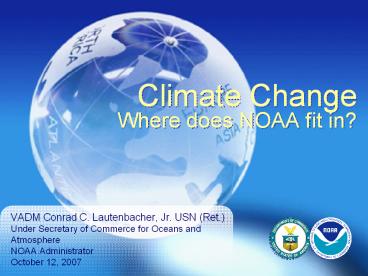Climate Change Where does NOAA fit in? PowerPoint PPT Presentation
1 / 15
Title: Climate Change Where does NOAA fit in?
1
Climate ChangeWhere does NOAA fit in?
- VADM Conrad C. Lautenbacher, Jr. USN (Ret.)
- Under Secretary of Commerce for Oceans and
AtmosphereNOAA Administrator - October 12, 2007
2
State of Climate Science
- Intergovernmental Panel on Climate Change (IPCC)
Reports - Noted warming of the climate system is
unequivocal - Most of the observed increase in globally
averaged temperatures since the mid-20th century
is very likely due to the observed increase in
anthropogenic greenhouse gas concentrations - Report found it likely human-induced warming
has had an influence on physical and biological
systems - Impacts will increase with increasing temperature
- Areas of Uncertainty
- Sensitivity of global systems to increased GHG
emissions - Impacts of identified regional climate changes
- The timing of impacts and the rate of changes
- The magnitude of changes and impacts at specific
scales
Research is crucial to understanding the impacts
of climate change and guiding public policy
3
NOAAs Role
- NOAAs Vision
- An informed society that uses a comprehensive
understanding of the role of the oceans, coasts
and atmosphere in the global ecosystem to make
the best social and economic decisions - NOAAs Mission
- To understand and predict changes in the Earths
environment and conserve and manage coastal and
marine resources to meet our nations economic,
social and environmental needs
4
From Climate Observations to Decision Support
- Climate Observations
- NOAA is the U.S. focal point for operational
environmental observations, for which climate is
a large part - We continue to develop strong observation and
data management infrastructure - Satellites
- Ocean observations
- Land observations
- Assure integration of these systems
- Decision Support
- NOAA produces a broad suite of climate
information and tools to help business, industry,
and governments plan for and adapt to future
climate and inform the decision making process
5
Supporting Adaptation
- The global climate will continue to change for
several decades, regardless of any mitigating
efforts we make now - The lag in the climate system makes adaptation
essential-so what can NOAA do - Operational challenges of higher resolution
improved predictability - Practical challenges of understanding climate
impacts at local and regional scales - Integrating these data into information that is
useful for decision making
6
ChallengesImprove Model Resolution
200 kmnow
50 kmtarget
4 kmobserved
7
Challenges El Niño Prediction
- El Niño / Southern Oscillation (ENSO) Observing
System - Computer models are starting to show skill in
forecasting tropical Pacific Ocean temperatures
one to two years in advance - Potential for hundreds of millions of dollars in
benefits to the US economy.
8
ChallengesEarly Warning Systems Example
National Integrated Drought Information System
9
ChallengesImprove Observing SystemsGlobal Earth
Observing System of Systems
10
Building a Climate Service
- A Climate Service is
- A Climate Service would
- A comprehensive system that monitors, collects
and integrates - Information on the key indicators of climate
- Develops credible, usable, accessible and timely
assessments and predictions of climate, - Trends, conditions, projections and impacts
that contributes to the welfare of the nation
- Provide the scientific basis for
- data, information, and products on climate
trends, conditions, predictions and impacts, at
local, regional, State, national to global scales - communication of climate information and risks to
decision- and policy- makers - improved coordination and use of existing
multi-agency prediction and assessment programs
11
Climate EducationNOAA is moving forward
- NOAA has just received authority to conduct
science education in all mission areas through
the America Competes Act - Partnership with the American Association for the
Advancement of Science (AAAS) to update and
expand national climate science education
standards - Provide national leadership for the International
Polar Year education campaign - Support climate survey to monitor public opinions
on climate - Promote Science On a Sphere and other spherical
displays to increase climate understanding
Students from the Portsmouth City school system
visit an installation of Science On a Sphere at
the Nauticus maritime science center as part of a
field trip facilitated by Hampton University
through an award from NOAAs Office of Education.
12
Questions?
13
Back-Up Slides
14
Climate Change Science Program
- Worlds largest Climate Change Scientific
Research Program - 1.7 Billion in 2006 (10.7 Billion 2001-2006)
1.7 Billion requested for 2007 - Includes 13 Federal Departments, Agencies, and
White House Offices - DOC, DOD, DOE, DOI, DOS, DOT, EPA, HHS, NASA,
NSF, OMB, OSTP, USAID, USDA, Smithsonian, CEQ - Goals
- Improve knowledge of the Earths past and present
climate variability and improve understanding of
the causes of observed variability and change. - Improve quantification of the forces bringing
about changes in the Earths climate - Reduce uncertainty in projections of how climate
systems may change - Understand the sensitivity and adaptability
ecosystems to climate - Inform policymakers and manage risks related to
climate variability and change
15
CCSP Assessment Activities
- CCSP agencies and scientists participate in a
wide range of international assessments - 21 CCSP Synthesis and Assessment Products
- Scenarios of GHG Emissions and Atmospheric
Concentrations and Review of Integrated Scenario
Development and Application - SAP 4.5 Effects of Climate Change on Energy
Production and Use in the United States - IPCC
- 120 U.S. scientists are IPCC authors 15 are
Review Editors - US Co-Chairs and Hosts IPCC WG I
- WMO/UNEP Ozone assessments (234 US contributors
to 2006 report) - Arctic Climate Impacts Assessment (87 US
contributors to 2004 report) - Millennium Ecosystem Assessment (219 US
contributors to 2005 report)

